
We kindly inform you that, as long as the subject affiliation of our 300.000+ articles is in progress, you might get unsufficient or no results on your third level or second level search. In this case, please broaden your search criteria.

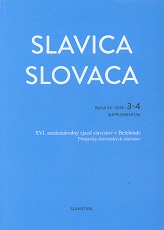
The paper is a part of a wider study with the research aim to learn about Slovak-language users’ means of language that primarily focus on human as a (non-)participant of a communicative act (personal deixis) and as a bearer of social roles and relations (social deixis). The subject of this research is explicit self-reference of a speaker in a dialogic communication. By explicit self-reference we mean self-identification of a speaker using a combination of verbal flexion together with personal pronoun I (ja). The study examines the relationship between verb semantics and explicit selfreferencing on the data of the Corpus of Spoken Slovak.Key words: personal deixis, social deixis, spoken communication, deictic center, Slovak language, the corpus-linguistic method.
More...
The part of elementary postulates of cognitive linguistics is the premise that metaphor is not only linguistic but also primary mental and culturally determined phenomenon that allows us to think and communicate about abstract entities as sensually perceived things or phenomena. Human being, his interpretation of the world is largely contingent on the correlation of physical and subjective experiences. This causes the same metaphors in genetically and typologically different languages. On the other hand, we register conceptual metaphors reflecting intercultural differences that are conditional on specific religious and cultural ideas, historical-ideological development of the given community and its cultural tradition. The aim of the work is cognitive analysis of conceptual metaphors of selected emotional concepts in Slovak language. The research of concept „profiling“ also implies broader cultural aspect.
More...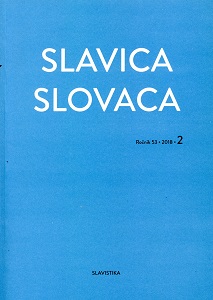
This paper provides basic information from the systematic and integrated research of the Cyrillic literature in Slovakia until the end of the 18th century with an emphasis on participation of the Slovak language and cultural horizons. The paper documents the progress of the project results opposing by the International expert panel.
More...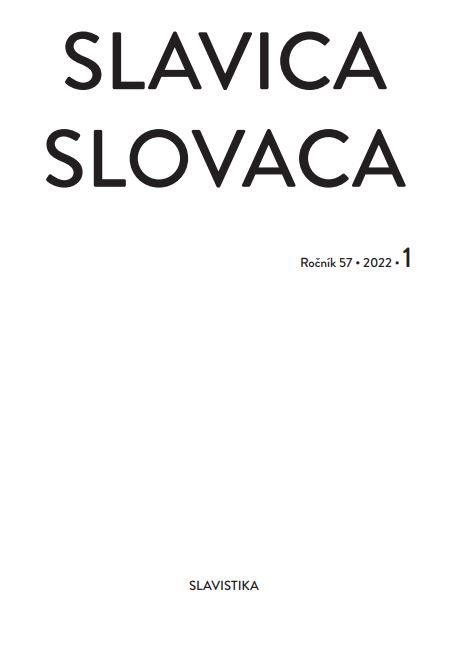
The image of Slovaks in Slovak and Ukrainian journalism is part of a broader comparison of research on the mentality of Slovaks and Ukrainians and contributes in the theory of knowledge to the linguistic and cultural image of both nations. In the study, the author describes those components (schemes and constructs) that have appeared in Slovak journalism over the past decade, as well as in Ukrainian journalism for the same period. It is therefore a matter of looking at the Slovaks from the inside (by themselves) and from the outside (by their neighbors – the Ukrainians). The author works with the corpus collocative method as one of the linguistic research methods and helps with the description with the method of psycholinguistics
More...
The development of Slovak Slavic science in the international context depends primarily on the competitiveness of its results, which are measurable in Slavic research especially in terms of their acceptance in the national and international context. The paper focuses on some program lines of Slavic scientific research, which are carried out in the environment of academic Slavic studies in coordination with the Slovak Committee of Slavists. In this context, cooperation with the International Committee of Slavists and Slavic research institutes abroad plays a special role.
More...
The paper presents a review of the scientific and research activities, as well as the projects carried out by the Commission for the Teaching of Slavic Languages and Literature, which include the theoretical and methodological foundations and practices of university teaching in relation to Slavic studies in Slavic and non-Slavic countries. A brief overview of the Commission’s scientific conferences and publications is put forward, illustrating the activities of the Commission to date and providing a review of methodological, linguo-methodological and didactic themes and competencies in the sphere of academic Slavic research and teaching. In a broader sense, the topic of the paper is linked to the Slavic movement and the activities of Slavists within the International Committee of Slavists (ICS).
More...
The goal of the study is to point to the polyfunctionality of adaptational morphemes of words borrowed from French to Slovak, the so-called French loanwords. The study takes into account the already-existing works on this topic together with the types of contact relationships between languages while it also characterizes the examined material. The principal part of the study is a quantitative-qualitative analysis of adjectival and verbal polyfunctional morphemes. Within these most represented word-classes we examine individual word-formation types and evaluate the ratio of identical morphemes in inflection and derivation. It turns out that one and the same morpheme has inflectional function in non-motivated French loan words while in the derived words which are motivated by word-formation motivation, it has derivational function. From the diachronic point of view, morphemes -antný and ‑izovať include a residual infix of dual character: grammatical (verbs) and word-formation (adjectives).
More...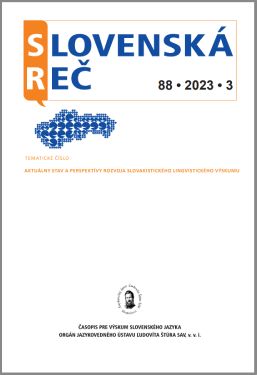
The article presents information about research and the most important outputs of the Ľudovít Štúr Institute of Linguistics of the Slovak Academy of Sciences in the last 6 years. It introduces the Institute as a Slovak language research center with a primary focus on basic language research, which has wide application in social life as well. At the same time, the Institute also focuses on theoretical and methodological issues, the connection between language and current social problems, and interdisciplinary research. The article presents in more detail the results and current activities in the fields of lexicography, corpus linguistics, natural language processing, terminology, social linguistics, onomastics, dialectology, historical-linguistic etc.
More...
The study presents an overview of the research activities of the Department of Slovak Language and Theory of Communication (DSLTC) of the Faculty of Arts at Comenius University Bratislava as one of the important Slovak workplaces. The aim of the contribution is to present the current results of linguistic Slovak research carried out at the DSLTC for the past five-year period and outline the research perspective. In order to present the institutional changes that the workplace has gone through, the paper contains also a brief information from the history of Slovak studies at the Faculty of Arts of Comenius University Bratislava. The synchronous state of Slovak language research within the scientific activity of the DSLTC is presented through the prism of the issues that the members of the department have dealt with in the past five years. The results of the investigation activity are clarified in the study through the analytical characteristics of the book publications. Special attention is paid to the interpretation of the research perspective of DSLTC in terms of the thematic focus of current research projects and planned research activities.
More...
The intention of the authors of the paper is to present the main areas of scientific research activities of the staff of the Department of Slovak Language and Literature at the Faculty of Arts of the UCM in Trnava. The authors’ attention is focused mainly on the current state of research, but they also briefly and selectively point out the short history of the department, as it is one of the youngest higher education institutions in Slovakia dedicated to research of national language and literature. The structure of the text reflects two stages of the department’s development, before 2016 and after 2016, when there was a significant change in staff. The overview of the current research activities of the members of the department also suggests further directions and challenges that this “young” department has to face.
More...
The paper presents 15 years of linguistic research and project outputs of the Department of the Slovak Language and Literature of the Faculty of Education at J. Selye University. The main fields of research were sociolinguistics, onomastics, linguistic landscape and machine translation, partially in terms of language contacts. The article also outlines the perspectives of further linguistic research at the Department of the Slovak Language and Literature.
More...
The study maps the scholarly research activities of the Department of Slovak Language and Literature of the Faculty of Arts and Letters of the Catholic University in Ružomberok with a focus on the results achieved within the framework of Slovak studies linguistic research in the years 2018 – 2023. The department is an institution with a mature, clearly formed research profile in the field of phraseology and didactics of Slovak as a mother tongue. In the field of phraseological research, the study approaches projects focused on biblical phraseology. Part of the text is, on the one hand, a description of the main publication outputs, which were the results of completed research of an international nature; on the other, an outline of the expected contribution of the current research, in which an interdisciplinary linguistic-theological approach is used in the analysis of biblical idioms and their motivational basis. In the field of didactics of Slovak as a mother tongue, the study presents key publications that reflect not only the history and current state of teaching Slovak, but (in relation to new challenges and perspectives in the European context) also outline certain prognoses and visions for this educational field. In further parts of the text, the research plans of the department towards the future are presented and its particularities and research focus are emphasized.
More...
The aim of the paper is to present the scientific research and publishing activities of the members of the Department of Communication and Literary Education at the Faculty of Education, University of Presov for the period of 5-6 years, i.e. 2018-2023. In the paper we present a brief history and the research focus of the department. The research expertise is related to the university preparation of future teachers at the pre-school and primary education. In separate sections we describe the scientific research and publication activities in the field of basic linguistic research, developmental linguistics, linguodidactics and popularization of language.
More...
The study presents the university departments currently engaged in Slovak studies in Ukraine. The aim of the paper is to outline the current scientific focus of the departments in continuity with their history, to present conference traditions and results of thinking about the construction and functioning of Slovak studies, including comparative Slovak-Ukrainian research. The study is not only descriptive and summarizing. The results of the knowledge of Ukrainian Slovak studies are placed in the context of domestic Slovak studies research and developed in discussion. In conclusion, we present perspectives of Slovak studies in Ukraine or joint Slovak-Ukrainian research.
More...
The paper focuses on Slovak studies and Slovak linguistic research at the second largest state university in Bulgaria – St. Cyril and St. Methodius University of Veliko Tarnovo (VTU). The history and traditions of Slovak language and literature teaching are presented. The first Slovak language lectureship at VTU was founded in the academic year 1978/1979. The paper gives a brief overview of contemporary educational programs in Slovak studies at the university. Attention is drawn to some specifics and tendencies in Slovak language teaching in Bulgaria and to Bulgarians. The paper presents the academic research and linguistic publication activities of the Slovak colleagues at the Department of Slavic Studies at the Faculty of Modern Languages of the University of St. Cyril and Methodius in Veliko Tarnovo for the period 2017 – 2023. Finally, the paper outlines some challenges faced by contemporary university Slavic studies. One of the solutions for increasing the interest towards Slavic languages, including Slovak, are interdisciplinary educational programs with flexible curricula, and also collaboration with foreign universities, cultural institutions, diplomatic missions and employers.
More...
The paper focuses on the current scientific and pedagogical activities of two (and the only) Slovak studies departments in Italy – at the Sapienza University of Rome and the University of Bologna in Forlì. The article traces the origins and development of Slovak studies in Italy and especially its current activities. The scientific and pedagogical activities at both universities are carried out through the activities of a lecturer, who also plays the role of a cultural mediator. In the paper the reader will find the main (especially) linguistic publications and their placement in the overall scientific-publication context.
More...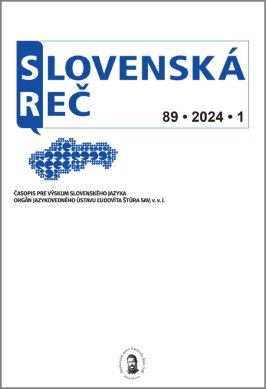
The article presents an analysis of four Slovak dialectal words from religious area that denote a religious person in Christian hierarchy. The reason why we analysed them together is a noteworthy fact that one of the semantic shift – "the top sheaf on the grain cross" – is common for all of them and the other one – "part of the vineyard press" – is connected with two of them. Since the motivation of all the analysed shifts seems to be connected with historical realities such as tithes, Christian art or garments, to explain the semantic development the method Wörter und Sachen is used.
More...
The study is devoted to Samo Tomášik’s national anthemic song Hej, Slováci! [Hey, Slovaks!] with the aim to commemorate the 190th anniversary of its birth and ensuing specific existence, with the special focus on its manifold text variations, translations, adaptations and various multigenre intertextual song references of different times. It presents the manuscript of the Tomášik’s text, first publication and the further life of the Slovak song Hej, Slováci! and its Czech adaptation addressing wider ethnic entity Hej Slované! [Hey, Slavs!] in the Slovak and Czech national cultural environment. Particular textological attention is focused on the comparison of salient characteristics of Tomášik’s text in its original Slovakized Czech version, literary Slovak version and the Czech adaptation. The core of the study focused on the linguistic peculiarities of the Tomášik’s song is framed by a “poetic echo“ of its literary evocation in the poetry of P.O. Hviezdoslav and other Slovak and Czech poets dedicated to the author and his anthemic song, being the evidence of its place in broad social consciousness and in the same time strengthening and fixating it as a living part of cultural memory.
More...
The article offers constructive criticism not only of the specialized tool "ludevít", machine translation into Štúr’s Slovak, but also the recently published critical overview of S. Habijanec (2023) of the aforementioned tool. The authors aim to refute some distorted claims that were published in Slovenská reč – the intention of creating "ludevít" and its limits, misleading claims about the organization and purpose of the literary competition Báseň v štúrovčine, and finally they discuss the (un)ethical usage of pupils’ and students’ works for scientific analysis. For these reasons, it can be assumed that not only the absence of more thorough preparation by S. Habijanec, but also the absence of addressing the author of the tool R. Garabík – for the sake of possible cooperation in order to improve the tool – prevented the critical view on "ludevít" tool, published in Slovenská reč in 2023, from fulfilling its potential.
More...